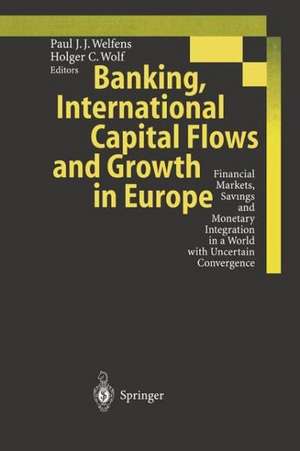Banking, International Capital Flows and Growth in Europe: Financial Markets, Savings and Monetary Integration in a World with Uncertain Convergence
Editat de Paul J.J. Welfens, Holger C. Wolfen Limba Engleză Paperback – 10 oct 2012
| Toate formatele și edițiile | Preț | Express |
|---|---|---|
| Paperback (1) | 953.03 lei 6-8 săpt. | |
| Springer Berlin, Heidelberg – 10 oct 2012 | 953.03 lei 6-8 săpt. | |
| Hardback (1) | 959.19 lei 6-8 săpt. | |
| Springer Berlin, Heidelberg – 18 aug 1997 | 959.19 lei 6-8 săpt. |
Preț: 953.03 lei
Preț vechi: 1162.23 lei
-18% Nou
Puncte Express: 1430
Preț estimativ în valută:
182.39€ • 188.97$ • 152.21£
182.39€ • 188.97$ • 152.21£
Carte tipărită la comandă
Livrare economică 21 martie-04 aprilie
Preluare comenzi: 021 569.72.76
Specificații
ISBN-13: 9783642638237
ISBN-10: 3642638236
Pagini: 476
Ilustrații: XIII, 458 p.
Dimensiuni: 155 x 235 x 25 mm
Greutate: 0.66 kg
Ediția:Softcover reprint of the original 1st ed. 1997
Editura: Springer Berlin, Heidelberg
Colecția Springer
Locul publicării:Berlin, Heidelberg, Germany
ISBN-10: 3642638236
Pagini: 476
Ilustrații: XIII, 458 p.
Dimensiuni: 155 x 235 x 25 mm
Greutate: 0.66 kg
Ediția:Softcover reprint of the original 1st ed. 1997
Editura: Springer Berlin, Heidelberg
Colecția Springer
Locul publicării:Berlin, Heidelberg, Germany
Public țintă
ResearchDescriere
Paul J.J. Welfens and Holger C. Wolf While the economies of Asia and, more recently, South as well as North America have enjoyed sustained high growth, the growth performance of western Europe and in particular continental Europe has been rather modest. Coupled with sizable improvements in labor productivity and - at best - steady capital productivity, growth proved insufficient to sustain employment levels, much less to replicate the US job creation success. Relative inflation performance has been much better: in the run-up to European Monetary Union inflation rates have dramatically converged towards the lower end of the distribution while risk premia on formerly high inflation economies have fallen. Yet, looking forward, the undoubted success in achieving price stability is mitigated by the lackluster growth -and in particular employment -performance. Indeed, the relative little attention paid to initiatives directed at raising economic growth is startling, not only in the light of the US policy record but also in light of the remarkable rebound of those European economies which have aggressively tackled the structural problems, most prominently the UK and Ireland.
Cuprins
Banking in Europe and Growth: P.J.J. Welfens: Banks, Capital Markets, R&D and Economic Growth in Europe: Banks and Capital Markets in Western Europe; Banking, Capital Markets and Economic Growth in Eastern Europe and Russia.- J. Priesemann: Policy Options for Prudential Supervision and Central Banks' Involvement; The Model Envisaged in the Maastricht Treaty; Challenges for Supervisors.- E. Gavrilenkov: Banking, Privatization and Economic Growth in Russia: Brief Chronicle of Banking Sector Developments during the Reforms; The Banking System and the Household Sector; The Radical Shift in Fiscal Policy, Money and Banking in 1995; Propensities for Economic Growth in Russia.- P. Hertner: Historical Lessons for Foreign Banking in Eastern Europe. The Case of Tsarist Russia: Foreign Banking in the 19th Century: Possible Choices and Real Development; Russia's Economic Development and its Foreign Debt between the 1860s and the First World War; Foreign Banks and Foreign Investment in Russia until the 1870s; Foreign Banking in Russia until the 1880s; Foreign Banking from the 1890s to the First World War; Foreign Banking in Russia on the Eve of World War I: Quantitative and Qualitative Evidence; Some Conclusions and Possible Lessons.- M. Bojanczyk: Restructuring and Privatization of Polish Banks: Restructuring the Banking Sector; Privatization of Polish Banks.- T. Lane: High Public Debt: Consequences for Investment and Growth: A Simple Framework; Endogenous Growth and Infrastructure; Ricardian Equivalence; Costs of Inflation; Empirical Evidence on Fiscal Policy and Growth; Political Economy and Regime Switching.- International Capital Flows and Growth: J.M. van Brabant: Banking, Foreign Investment, Endogenous Growth and Systemic Transformation: The Holy Trinity and Successful Transformation; Towards Modernization and FI; Towards Endogenous Growth; Expectations and Realities about FI Inflows; Some Illustrative Negative Aspects of FI; Economic Development and FI; The Experience of South and East Asia and the PETs; Managing FI and Financial Restructuring - Lessons for PETs.- E.B. Koch: Capital Flows in eastern Europe: Some Lessons from the Emerging Markets in Latin America and Asia: Capital Inflows to Central Europe: Stylized Macroeconomic Features Influencing Capital Flow Experiences in Latin America, Asia and Central Europe; Composition of Capital Flows; Some Key Policy Issues.- T. Gries, A. Schweinberger: Catching Up Economies in Transformation: A Model of an Economy in Transformation; Dynamics of the Transition Economies; The Employment Problem.- H.C. Wolf: Savings, Credit markets and Economic Growth in Europe: The Setting; Savings: Quantitative Aspects; Savings: Allocative Aspects.- E.M. Graham: US Multinationals and Europe: An Update: Possible Reasons for US Direct Investment in Europe.- J. Stankovsky: Multinational Investment and Economic Growth in Eastern Europe: Introduction: Volume and Growth of Foreign Direct Investment in the East; The Role of FDI in the Transformation of Eastern Europe: Expectations: Economic Growth and Investment in Eastern Europe: Recent Developments; Second Thoughts Concerning the Role of FDI in Eastern Europe; Importance of FDI for Eastern Europe; Are There Negative Secondary Effects of FDI in Eastern Europe?; Absorption Capacity of eastern Europe for FDI; A Short Conclusion.- Panel Discussion: The Bank's Role in Financing Economic Expansion in Eastern Europe: R. Nyers: Recent Developments in the Hungarian Financial Sector.- W. Varga: Zur aktuellen Situation in der Bankwirtschaft der Reformländer.
Caracteristici
Up-to-date information about capital-flows and the role of banks in the economy * Theoretical as well as political analysis















